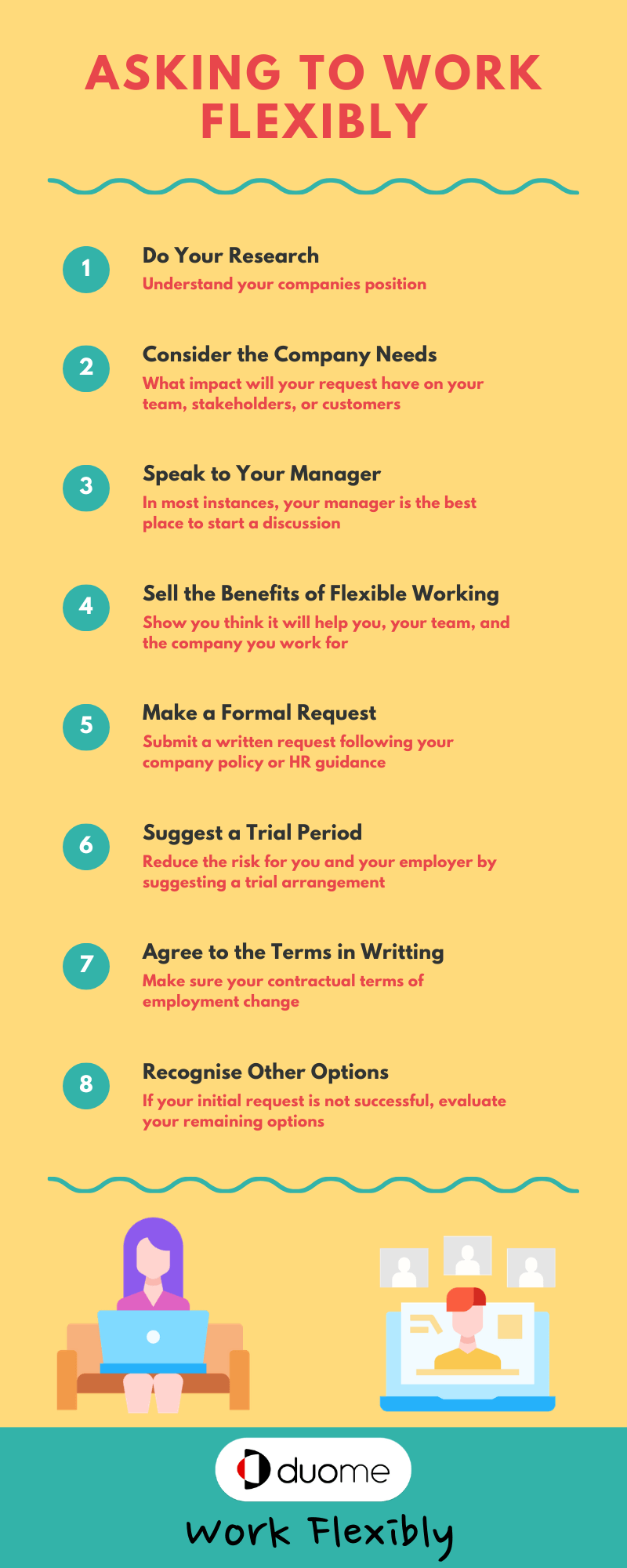For many, lockdown has created new opportunities to work flexibly that may not otherwise have been considered plausible. New homeworkers have been enjoying the flexibility that comes from being able to control your own workday, which has led to an overall increase in productivity and wellbeing for many.
As we ease back into normality, employees are now expected to return to their contracted work situation which may no longer be right for you. Asking to work flexibly to formalise your lockdown working pattern will reduce any anxiety you may be feeling about returning to work and can create a more favourable working relationship for you and your employer.
How to Ask Your Employer to Work Flexibly Longterm
There is a myriad of reasons why you might like to work flexibly, ranging from saving the cost of your commute to being able to drop your kids off at school or attend a morning fitness class.
You may also prefer to manage your working hours around your natural productivity levels. Perhaps you conk out in the afternoons, but power through your work around midnight or like to get things done early in the mornings. If so, flexible working can boost your performance to benefit your company.

1. Do Your Research
Take time to understand your company’s workforce and review their flexible working policy. Research how many people have flexible working arrangements, and how likely it is that your request for homeworking or flexible hours will be approved.
2. Consider the Company Needs
Lockdown has forced companies and teams to adapt, which has led to the implementation of new systems and procedures to facilitate this. Some companies did this easily, whilst others made it work out of necessity.
Think about your company structure and how your flexible working pattern might impact others in your team. Consider the hours of service and when the business needs to be open, as well as team collaboration and the overall workplace culture.
The type of work you do has an impact on company needs. Client facing roles, working in larger teams and problem-solving roles where employees are encouraged to bounce ideas around the office to find the best approach are likely to require some office work.
3. Speak to Your Manager
Usually, a friendly conversation with your manager will be the most effective place to start. Let your manager know you have enjoyed working from home during lockdown and state you would like to continue with your flexible working pattern.
4. Sell the Benefits of Flexible Working
Create a robust list of reasons to highlight why working from home is right for you, then sell it in a way that shows why the company will benefit by allowing you to keep your lockdown working pattern in place.
Each person is different, so you may like to consider reasons such as social distancing, enhanced productivity, the ability to provide extended hours for improved customer service, lowering the company’s carbon footprint and reduced company operating costs as excellent benefits to homeworking.
The secret is to put your own needs first, then present it in a way that removes obstacles and caters to the company’s operational needs.
5. Make a Formal Request
Once you’ve discussed your needs with your manager, submit a formal request to your human resources department. Ensure you follow the company’s procedures for requesting a flexible working arrangement. Keep a clear record of your communication and always communicate in writing.
6. Suggest a Trial Period
Flexible working can raise unexpected challenges. Suggesting a trial period keeps the door open for you to reassess to see if homeworking is right for you under normal circumstances.
You may find you miss working alongside others, or feel less motivated on bad days, so having an exit strategy at the end of the trial period can help both you and your employer feel more confident about changing your working pattern.
7. Agree to the Terms in Writing
Once you have smoothed out the details, agree to the terms in writing and have your contract amended to reflect the changes. There should be a clear start date, and a process in place for returning to your regular working pattern should flexible working become challenging for you.
8. Recognise Other Options
Lockdown has led to a significant shift in attitude towards homeworking arrangements, but employers are not obligated to approve your request. It’s important to realise that your request to keep your flexible lockdown working pattern may be declined.
Be realistic about your chances of being granted your request and consider your options before making your request. If your application is declined this could mean simply leaving it for a few months and making another request, changing your strategy for selling the benefits to your manager or revamping your CV for a different job that’s better suited to your new workplace needs.
Consider all possible outcomes, and be open to all opportunities.
What to Do if Your Request for Flexible Working is Declined
In all instances, you should follow your company’s operating procedures.
Employers are entitled to decline requests for flexible working should this not meet their business needs. Companies may highlight issues such as extra operating costs, evidence of reduced productivity, the potential for decreased quality and less ability to meet customer demand, which are all valid reasons why you may not be granted your request.
If your employer has not reasonably considered your request, denied you opportunities to progress or reduced your pay without reason, discriminated against you due to your request for flexible working or rejected your application based on incorrect information, you can complain to the employment tribunal if your request for flexible working is declined by your employer.
ACAS the government-funded public body to provide advice to employers and employees on employment matters has some good guidance here.
Top Tips for Negotiating a Flexible Working Pattern After Lockdown
If you’re ready to make the shift into a flexible working pattern, then asking your employer to enable a homeworking schedule needn’t be difficult if you follow this simple formula for finding a great solution that works well for both of you.
Start with the best scenario based on your own needs, then be prepared to find a middle ground.
Make it as easy as possible for your employer to facilitate a flexible working pattern.
Present your request alongside a tangible action plan with a workable solution. Giving your employer the information they need reduces employer resistance, creating a positive working pattern change that can benefit both parties.
Show you have done your homework, present examples of other people working flexibly in your organisation to strengthen your case.
Finally, don’t be afraid of suggesting a trial period to see how it works, it’s in your interest that it works for you and your employer effectively.
Homeworking is an ideal arrangement that can boost your productivity, improve your work-life balance and save costs. If it suits you, it’s well worth asking for your lockdown work pattern to become your new, flexible working arrangement.







